Ledger is considered one of the safest hardware wallets for storing crypto. However, as of 2025, an increasing number of users are considering alternatives that could potentially offer even stronger security and better transparency. It turns out there are quite a few options out there worth considering. In this guide, we have zeroed in on eight such popular Ledger alternatives — read on as we explore their strengths, weaknesses, and more.
KEY TAKEAWAYS
➤ Ledger hardware wallets still provide some of the strongest security for self-custody of your crypto.
➤ Some Ledger alternatives may offer better performance or features depending on your specific security and usability needs.
➤ Key factors to consider while choosing a Ledger alternative include security, compatibility, ease of use, and recovery options.
Ledger wallet alternatives to consider
If the current direction of Ledger disconcerts you, do not fear. There are other hardware options on the market. Here are some solid Ledger wallet alternatives to look at:
1. Trezor: Best in terms of global positioning
What is it, and how does it work?
Like a standard hardware wallet, Trezor provides secure storage for your crypto. Moreover, Trezor wallets aim to dissociate your private keys from online exposure by using the device itself and the wallet interface — a web-based app.
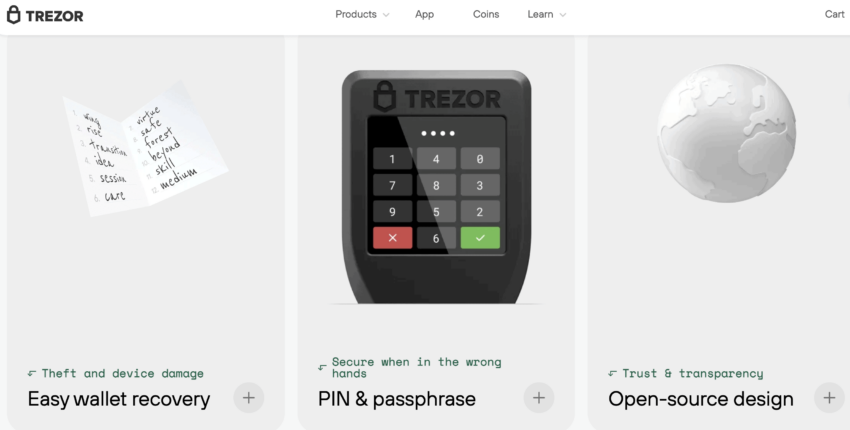
Trezor, in 2025, continues to follow the quintessential approach to hardware wallet setups with standard key pair initialization, recovery seed generation, a two-interface transaction signing gig, and the PIN-Passphrase combo for additional security.
Highlights
- Seamless UI
- Supports a diverse range of cryptos, with the Model One supporting almost 1300 cryptos and Model T closing in on almost 1500 assets
- Model T features the “Shamir Backup” functionality, allowing users to have a 16-way share feature activated for your seed phrase. This way, your seed phrase isn’t stored in one place but is shared across locations.
What makes it better than Ledger?
Unlike Ledger, Trezor’s software is open-source, making critical changes community-centric and hence more transparent. Also, setting up or using Trezor wallets does not require legacy user registrations using IDs.
Moving to specifics, Ledger uses the Secure Element chip — a security implementation that needs specific agreements and stops it from being open source. Trezor uses the STM32 microcontroller that is open to community-based audits.
Hits
- Open-source wallet with firmware and software that people can contribute towards
- The built-in security module hinges on one microcontroller and isn’t a dual-chip setup.
- Top-tier models can support close to 1500 cryptocurrencies.
Misses
- No built-in app or Bluetooth support
- Doesn’t actively support staking
Get one of the most trusted Ledger alternatives the market has to offer. Shop Trezor today!
2. Safepal: Best for QR code support
What is it, and how does it work?
SafePal’s crypto storage suite extends to hardware and even software offerings, with one app — the SafePal app — managing all. Note that it is a conglomerate backed by Binance Labs and best known for the S1 hardware wallet.

The wallet operation is simple, with activation generating a pool of keys. Plus, the recovery seed still needs to be written down, whereas the transactions via wallets follow a QR-code-based offline approach to minimize online threats. And yes, the PIN-passphrase combo continues to exist even here.
Highlights
- QR-code access and a mobile-first approach ensure that the wallet itself isn’t overexposed and is always air-gapped.
- SafePal’s usability extends to 48+ blockchains, NFTs, and over 100+ million assets.
- As for security, there is a dedicated Cypher “Seed Protection” board to safeguard mnemonic phrases from corrosion, fire, and water. This board can work with other hardware wallets from Trezor and Ledger.
What makes it better than Ledger?
While Ledger offers the “Recover” feature to have a cloud-like backup for seed phrases, SafePal does better with its proprietary “self-destruct” feature. Also, while you need to plug in Ledger wallets to a PC for transactions, SafePal’s QR functionality is via a mobile device and can be used offline.
Hits
- Cost-effective wallet
- In association with Travala and Rarible
Misses
- QR-based usage might feel a tad cumbersome
- Not an open-source wallet
Secure your crypto assets with the SafePal wallet today!
3. Ballet wallet: Best paper-like Ledger alternative
What is it, and how it works?
The Ballet wallet feels like a standard, thick credit card and is supposed to work like a paper wallet. Founded by Bobby Lee, the Ballet wallet is simple to understand and use. The wallet only houses a QR code sticker on its front, which is the receiving address of your BTC.

In simple terms, the Ballet Wallet is supposed to be a bearer instrument. The product itself is made of 304-Grade stainless steel. And while it is primarily marketed as a bitcoin hardware wallet, it can accommodate other tokens when the card is used alongside Ballet’s phone or desktop wallet.
Highlights
- The best thing about the Ballet wallet is its uncomplicated setup.
- Users can always be in possession of the card without ever needing to plug it in anywhere.
- Plus, the QR code approach for checking balances is seamless and effortless.
What makes it better than Ledger?
It is the unique physical-only design that makes the Ballet wallet stand out. You do not need complex wallet apps and chip-based setups to get started, as the wallet itself feels like a “physical bearer” instrument. And yes, as it looks like a credit card, you can slot it within your physical wallet or the car dashboard if needed. It isn’t fancy enough to be worn as a necklace.
Hits
- No need for cumbersome frills regarding two-factor authentication
- Looks and works like a standard paper wallet with QR functionality
- Can be carried around without being noticed
- No worries about software-specific breaches
- Perfect for crypto beginners
Misses
- As it is a bearer instrument, losing the Ballet wallet might mean forsaking funds forever.
- The keys are not exactly on the metallic surface but engraved on the plastic sticker, which makes them prone to scratches, wear-and-tear, and heat-based damage.
- Transactions still need to move through the Ballet app and hence aren’t completely offline.
4. Grid.Plus Wallet: Best for EVM interactions
What is it, and how does it work?
GridPlus’s Lattice 1 is a programmable hardware wallet that can help you store a wide range of digital assets, courtesy of its unique connectivity traits.
Importantly, the Lattice 1 from GridPlus isolates your private keys — protecting your assets even if an attacker gains control of the physical device.
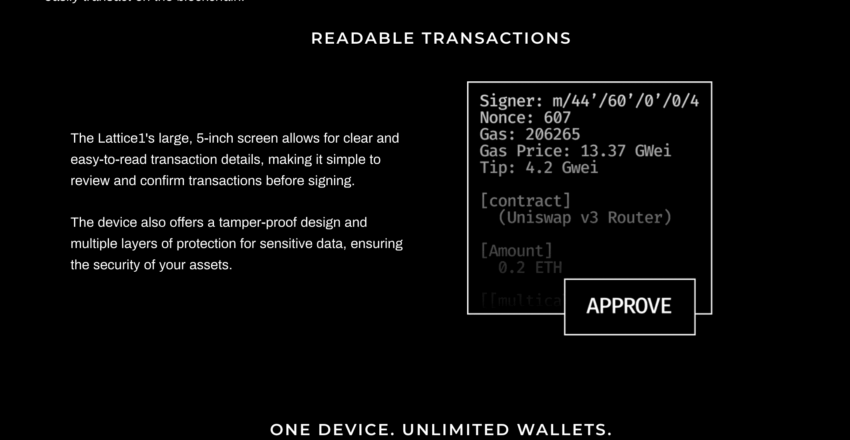
Highlights
- It can serve as a functional Ethereum node and direct blockchain interactions.
- Has an initiative touch interface courtesy of a 5-inch TFT screen
- Comes with a proprietary SDK for developers to build on top of it
- Pin-protected Safecards in existence
What makes it better than Ledger?
First of all, with Lattice 1, there is no need to register using government-specific documents or any document whatsoever. And the unique Safecard-feature with PIN support ensures account recovery, unlike Ledger’s new cloud-based initiative. Plus, any intrusion attempt associated with the Lattice can trigger a complete data wipe — adding to the failsafe mechanism.
Hits
- Comes with a secure computing environment supporting programmability
- Safecards allow you to move seamlessly between different wallet accounts
- Offers a wide range of connectivity-focused traits, including Wi-Fi and USB.
Misses
- On the expensive side
- Feature-rich UI isn’t suitable for crypto beginners
- Power outlet need, minimizing portability
- For accessing the Ethereum EVM chain, Lattice 1 still needs the MetaMask extension.
Use the GridPlus wallet to secure your crypto today!
5. Coldcard: Best Ledger alternative for failsafe features
What is it, and how does it work?
There are many wallets with multi-crypto and blockchain access. But if you seek a wallet only for your BTC, nothing beats Coldcard’s utility. Developed by Coinkite in 2019, the Coldcard wallet MK4 (the most popular) is intended to stay completely offline and boasts a tamper-proof secure element processor.
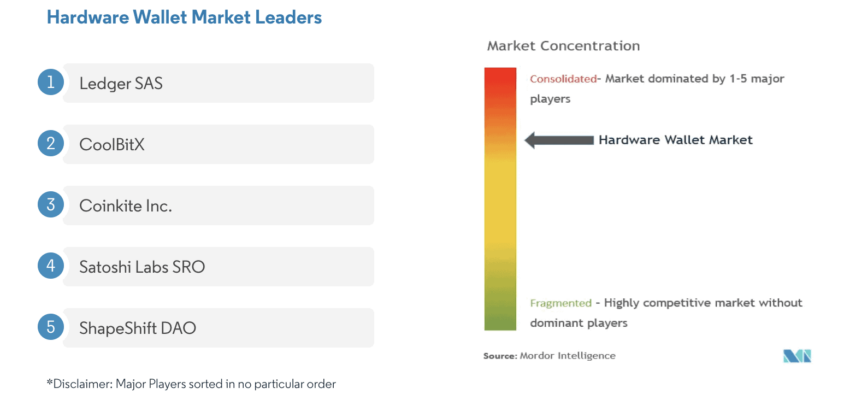
Setting up and using the wallet is easy. Once you initialize, the wallet generates your private and public keys, followed by the 24-word seed phrase. You still need to write the seed phrase securely. In terms of transaction signing, Coldcard’s M4 uses the PBST technique — Partially Signed Bitcoin Transactions — allowing you to use an SD card to load details into the wallet and then use the private key to sign.
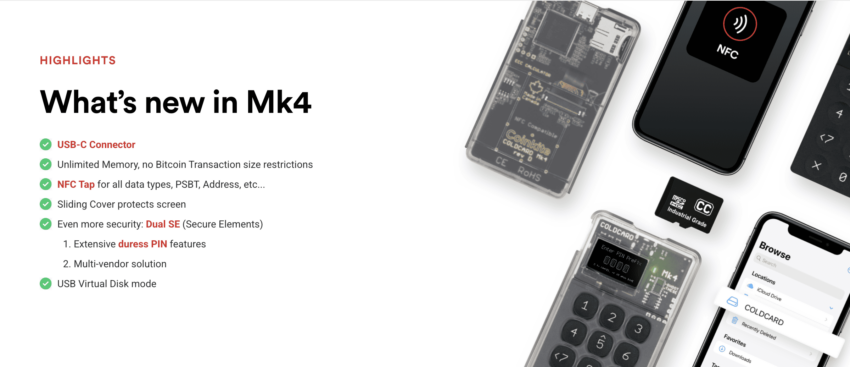
Highlights
- Uncompromising security in the absence of internet connectivity
- One of the best Ledger wallet alternatives with a bitcoin focus
- Truly air-gapped
- Comes with an optional passphrase and PIN protection
- Comes with a Brick-me-Pin as a failsafe, data-wiping arrangement
- Boasts a “Duress Pin” functionality to mislead attackers
What makes it better than Ledger?
For starters, Coldcardworks without any form of internet access. Plus, there is no need to plug in this hardware wallet to any computer, unlike Ledger devices that look and act like pen drives. Also, as of now, there is no need to register using legacy documents.
Hits
- Offers multi-signature steps
- Transparent operation and tamper-proof
- Secure element chips like the ones in credit card
- Comes loaded with a “Login Countdown” feature to delay access during stressful times.
- Features two unique anti-phishing words.
Misses
- BTC-only hardware wallet
- SD card transfer means the user needs to carry another physical device
- No touchscreen
6. KeepKey: Best Ledger alternative in terms of display
What is it, and how does it work?
The KeepKey wallet from ShapeShift dates back to 2015 and works with a wide range of cryptocurrencies. The idea is that private user keys are kept completely offline.
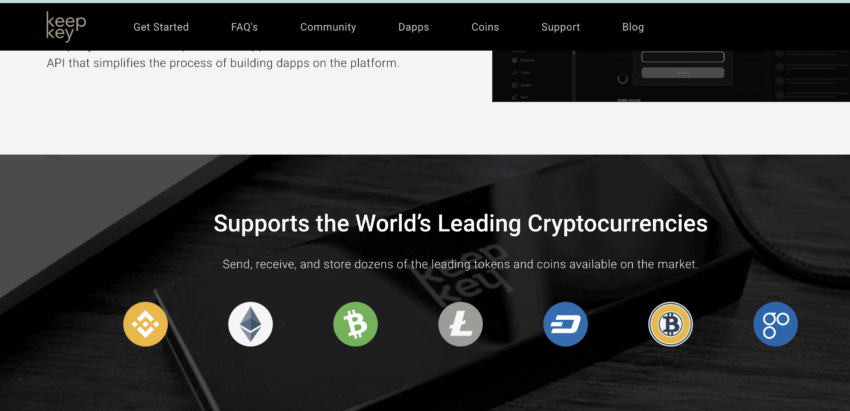
While KeepKey wallet initialization and seed phrase handling remain the same, transaction signing requires access to KeepKey’s Chrome browser extension or third-party software integrations. And even though an internet connection is needed, the signing happens within the wallet securely. Also, a KeepKey DApp guarantees safer access.
Highlights
- Large display
- Sleek design and easy-to-carry
- Supports bitcoin, litecoin, ethereum, and other popular cryptos
- Can support limitless wallet addresses
- Lets you customize transaction speeds
What makes it better than Ledger?
KeepKey keeps things simple. It doesn’t offer any seed phrase-backing-up feature. Plus, setting up the wallet doesn’t require any government-authorized ID.
Hits
- The OLED screen is easy to view
- A minimal device with a solid build
- A lower price point than other Ledger alternatives
- Allows you to interact directly with the ShapeShift exchange
Misses
- Not the most portable device around
- Doesn’t include secure element processors for enhanced security
- Crypto spread is lower compared to others on the list
7. Blockstream Jade: Best for bitcoin
What is it, and how does it work?
If you are specifically interested in storing BTC, Blockstream Jade makes quite a compelling case. This hardware wallet lets you store your private keys in an offline capacity, all while letting you sign transactions without online connectivity. Blockstream Jade gives the impression of an air-gapped wallet — taking security very seriously.
Apart from the security, it is the touchscreen UI that stands out. Additionally, you can set a 24-word seed phrase, verify transactions directly from the screen, and even take encrypted backups using the microSD card.
Highlights
- Boasts multi-sig support
- Made of anti-tamper and durable materials
- Brings in USB Type-C support and the flexibility to work with QR codes
- Uses a secure chip to store private keys.
What makes it better than Ledger?
- Features an open-source design, facilitating community audits
- Only focuses on Bitcoin to keep the threat area to a minimum.
Hits
- Advanced physical design
- Supports code reviews made by the community
- The multi-sig functionality offers enhanced security.
Misses
- The touch interface might be prone to scratches.
- Doesn’t support altcoins.
Honorary mentions: other Ledger wallet alternatives to consider
The eight Ledger wallet alternatives that we discussed offer a solid variety for users. And while the mentioned ones are slowly moving up the popularity charts, here are a few more — both hardware and software wallets — that offer advantages over Ledger wallets.
- Exodus wallet
Exodus is a software or rather a hot wallet with no hardware requirement. There is no need to provide registration and identification details. Plus, the Exodus wallet supports 100+ digital assets and also has built-in exchange support to facilitate quick trades.
- CoolWallet S
CoolWallet is strictly hardware, designed like a credit card, and allows smartphone connectivity via Bluetooth. It is water-resistant, brings biometric authentication into the mix, and doesn’t require ID-based registrations. CoolWallet S — the most popular BTC hardware wallet from the brand — is water-resistant and even tamper-proof.
- ELLIPAL wallet
Consider the ELLIPAL wallet if you seek an air-gapped solution for your crypto storage needs in 2025. There is no need for cables or even Bluetooth connectivity. And even though the ELLIPAL wallet is a tad bulky, its large screen makes up for this minor issue.
- Coinbase Wallet
This is an exchange-based wallet with no need for separate registration. And while standard KYC rules hold and there is still internet access involved courtesy of it being a hot wallet, the Coinbase Wallet trumps others due to its support for ERC-20 tokens and a wide range of crypto assets.
Why is Ledger in the crosshairs of the crypto community?

Ledger continues to be a market leader when crypto hardware wallets are concerned. Yet, for a number of reasons, the crypto community is turning its back on Ledger.
The abduction of David Balland
The recent kidnapping of Ledger co-founder David Balland and his wife in January 2025 was a criminal act with no direct link to Ledger’s practices. However, the incident could still raise concerns about security risks in the crypto industry, which in turn, could indirectly affect the company’s reputation.
The incident underscores the personal risks faced by individuals in the crypto space and highlights potential security vulnerabilities. The attackers demanded a ransom in cryptocurrency, part of which was paid (and recovered later) before French authorities intervened.
Among other things, this event could lead to increased scrutiny of Ledger’s security measures. It may even somewhat erode customer confidence in the company’s ability to protect funds — again, even though the event did not necessarily reflect any wrongdoing by Ledger.
The only silver lining would be that the swift rescue operation and the arrest of ten suspects may help limit the negative perceptions in the long run.
The controversial firmware update
Ledger’s new firmware upgrade — v2.21 — introduces a subscription-based seed phrase recovery feature — “Recover.” As convenient as this might sound, it gives the company the option to have parts of the “seed phrase” handy, which to many feels like a breach of trust. Especially in a crypto space that hinges on “trustlessness.”
“Today, we’re proud to announce Ledger Recover, an upcoming and optional service for users who want a fully secure backup of their Secret Recovery Phrase.”
Pascal Gauthier, CEO of Ledger: Twitter
Ledger previously mentioned that users’ private keys would never leave the secure element chip. Some crypto folks believe that the new “Recover” feature doesn’t align with that.
Ledger provided an update on its optional subscription service in September 2025. This company confirmed that the new paid service allows users to back up their wallet access by encrypting and splitting their seed phrase into three fragments, each stored by separate entities.
If a device is lost or stolen, users can recover their wallet through identity verification. Ledger Recover remains optional and requires explicit user consent. Those who prefer full self-custody can continue managing their seed phrases independently.
User-registration
Pseudonomity is a huge deal in crypto. Yet, Ledger’s new wallet update makes ID-based user registration a mandate for users to access the “Recover” functionality. Do note that the user registration, in this case, will need a government-issued identity card — signifying further privacy erosion.
The gimmicky necklace
In April 2023, Ledger faced a similar criticism, albeit on a smaller scale, when it flaunted its hardware wallet necklace. This move bewildered many as a stylish necklace is bound to attract theft.
Furthermore, Ledger has suffered a number of data security breaches, with nearly 270,000 physical user addresses being freely shared in 2020 alone. And despite the breach, the response to it, especially from the CEO, felt quite underwhelming.
As of now, the firmware update only extends to Ledger’s Nano X wallet but may be extended to other offerings. And while Ledger, including the CEO, has defended its new offering, mentioning that security implementations like Liveness detection are in place, the community hasn’t taken to it kindly.
“You’re saying this is not what customers want. Actually, this is what future customers want.”.This is the way that the next hundreds of millions of people will actually onboard to crypto.”
Pascal Gauthier, CEO of Ledger: Twitter Spaces
It should be stressed that the feature is “optional” and not forced.
Here is a thread that captures the technical and implementational elements of this feature:
Per the latest open-source roadmap released by Ledger on May 24, 2023, the company seems to have plans to make a majority of its OS open-source. This would also include the Ledger Recover, according to the official release. Once done, this will make Ledger Recover auditable. Ledger also mentioned that unless the Ledger Recover code is published and used to prepare individual backup providers, the core and controversial feature wouldn’t see the light of day.
Is it time to look beyond Ledger?
Ledger is still one of the market leaders when hardware self-custody crypto wallets are concerned. However, considering Ledger wallet alternatives makes sense if the company moves towards a more centralized approach (as its direction in 2023 indicated). And while we have prepared a detailed list for you, it all boils down to your preferences. Before making a decision, make sure that you do your due diligence and choose a wallet that meets your security, accessibility, and usability needs.
Frequently asked questions
There are many alternative wallets to Ledger if you desire cold storage. Some of these include Trezor, Ballet Wallet, NGrave, and SafePal. Although if you desire hot wallets, you can use Exodus or Coinbase wallet.
Ledger and MetaMask have two different scopes in terms of cryptocurrency storage and security. Ledger is a cold wallet that favors offline storage for a plethora of assets. MetaMask is primarily an Ethereum and EVM-centric hot wallet that is a browser extension or mobile wallet.
Traditionally, Ledger has maintained a reputation for industry grade security. For some time it was considered the best wallet for cold storage. In its latter years, the company has taken quite a few hits to its reputation due to a few controversial decisions and operational security oversights.
If you own any cryptocurrency, it is best to own a cold wallet. Although Ledger has garnered a reputation for industry grade security, there are many alternatives that are just as safe. You do not have to own a Ledger cold wallet specifically.
There is no fool-proof security system around, but Ledger still does a great job by encrypting customer details via a secure element chip. However, previous instances of data breaches corresponding to Ledger wallets have occurred. Also, with the new ID-based seed phrase recovery feature, a lot of users are skeptical that there would be third parties involved — opening a backdoor for hackers and breachers.
Disclaimer
In line with the Trust Project guidelines, the educational content on this website is offered in good faith and for general information purposes only. BeInCrypto prioritizes providing high-quality information, taking the time to research and create informative content for readers. While partners may reward the company with commissions for placements in articles, these commissions do not influence the unbiased, honest, and helpful content creation process. Any action taken by the reader based on this information is strictly at their own risk. Please note that our Terms and Conditions, Privacy Policy, and Disclaimers have been updated.




